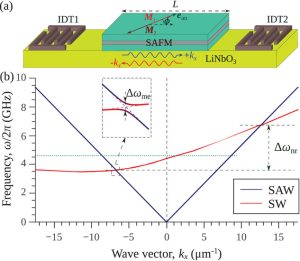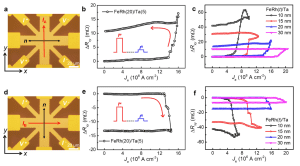 The advantage of an ultrafast frequency-tunability of spin-torque nano-oscillators (STNOs) that have a large (>100 MHz) relaxation frequency of amplitude fluctuations is exploited to realize ultrafast wide-band time-resolved spectral analysis at nanosecond time scale with a frequency resolution limited only by the “bandwidth” theorem. The demonstration is performed with an STNO generating in the 9 GHz frequency range and comprised of a perpendicular polarizer and a perpendicularly and uniformly magnetized “free” layer. It is shown that such a uniform-state STNO-based spectrum analyzer can efficiently perform spectral analysis of frequency-agile signals with rapidly varying frequency components.
The advantage of an ultrafast frequency-tunability of spin-torque nano-oscillators (STNOs) that have a large (>100 MHz) relaxation frequency of amplitude fluctuations is exploited to realize ultrafast wide-band time-resolved spectral analysis at nanosecond time scale with a frequency resolution limited only by the “bandwidth” theorem. The demonstration is performed with an STNO generating in the 9 GHz frequency range and comprised of a perpendicular polarizer and a perpendicularly and uniformly magnetized “free” layer. It is shown that such a uniform-state STNO-based spectrum analyzer can efficiently perform spectral analysis of frequency-agile signals with rapidly varying frequency components.
This article has been published by ACS Nano Letters and is available here.

 A theory of a detector of terahertz-frequency signals based on an anisotropic antiferromagnetic (AFM) crystal is developed. The conversion of a THz-frequency electromagnetic signal into the DC voltage is realized using the inverse spin Hall effect in an antiferromagnet/heavy metal bilayer. An additional bias DC magnetic field can be used to tune the antiferromagnetic resonance frequency. We show that if a uniaxial AFM is used, the detection of linearly polarized signals is possible only for a non-zero DC magnetic field, while circularly polarized signals can be detected in a zero DC magnetic field. In contrast, a detector based on a biaxial AFM can be used without a bias DC magnetic field for the rectification of both linearly and circularly polarized signals. The sensitivity of a proposed AFM detector can be increased by increasing the magnitude of the bias magnetic field, or by decreasing the thickness of the AFM layer. We believe that the presented results will be useful for the practical development of tunable, sensitive and portable spintronic detectors of THz-frequency signals based on the antiferromagnetic resonance (AFMR).
A theory of a detector of terahertz-frequency signals based on an anisotropic antiferromagnetic (AFM) crystal is developed. The conversion of a THz-frequency electromagnetic signal into the DC voltage is realized using the inverse spin Hall effect in an antiferromagnet/heavy metal bilayer. An additional bias DC magnetic field can be used to tune the antiferromagnetic resonance frequency. We show that if a uniaxial AFM is used, the detection of linearly polarized signals is possible only for a non-zero DC magnetic field, while circularly polarized signals can be detected in a zero DC magnetic field. In contrast, a detector based on a biaxial AFM can be used without a bias DC magnetic field for the rectification of both linearly and circularly polarized signals. The sensitivity of a proposed AFM detector can be increased by increasing the magnitude of the bias magnetic field, or by decreasing the thickness of the AFM layer. We believe that the presented results will be useful for the practical development of tunable, sensitive and portable spintronic detectors of THz-frequency signals based on the antiferromagnetic resonance (AFMR). Previously, it has been shown that rapid cooling of yttrium-iron-garnet–platinum nanostructures, preheated by an electric current sent through the Pt layer, leads to overpopulation of a magnon gas and to subsequent formation of a Bose-Einstein condensate (BEC) of magnons. The spin Hall effect (SHE), which creates a spin-polarized current in the Pt layer, can inject or annihilate magnons depending on the electric current and applied field orientations. Here we demonstrate that the injection or annihilation of magnons via the SHE can prevent or promote the formation of a rapid cooling-induced magnon BEC. Depending on the current polarity, a change in the BEC threshold of −8% and +6% was detected. These findings demonstrate a new method to control macroscopic quantum states, paving the way for their application in spintronic devices.
Previously, it has been shown that rapid cooling of yttrium-iron-garnet–platinum nanostructures, preheated by an electric current sent through the Pt layer, leads to overpopulation of a magnon gas and to subsequent formation of a Bose-Einstein condensate (BEC) of magnons. The spin Hall effect (SHE), which creates a spin-polarized current in the Pt layer, can inject or annihilate magnons depending on the electric current and applied field orientations. Here we demonstrate that the injection or annihilation of magnons via the SHE can prevent or promote the formation of a rapid cooling-induced magnon BEC. Depending on the current polarity, a change in the BEC threshold of −8% and +6% was detected. These findings demonstrate a new method to control macroscopic quantum states, paving the way for their application in spintronic devices. Magnetoelastic coupling is considered as one of the most reliable methods to induce nonreciprocity of propagation losses of microwave-frequency surface acoustic waves (SAW) and other acoustic modes propagating in nonmagnetic-ferromagnetic heterostructures. Here, it is demonstrated theoretically that magnetoelastic coupling can also induce phase nonreciprocity of SAW, which is necessary for the development of SAW circulators and other nonreciprocal solid-state-acoustic devices. In contrast to previous studies, induction of the phase nonreciprocity requires the coupling of SAW to a strongly nonreciprocal spin wave (SW), having the nonreciprocal splitting of the SW spectrum much larger than the strength of the magnetoelastic coupling, which, in turn, should be much larger than the geometric mean of the SW and SAW damping rates. In this case, the hybridized SAW in the spectral region between the magnetoelastic gaps demonstrate significant phase nonreciprocity, retaining, at the same time, propagation losses that are close to those of unhybridized SAW. Possible practical realization of nonreciprocal SAW phase shifters and SAW-ring-based circulators based on hybridized waves in acoustic crystal and synthetic antiferromagnetic heterostructures is discussed.
Magnetoelastic coupling is considered as one of the most reliable methods to induce nonreciprocity of propagation losses of microwave-frequency surface acoustic waves (SAW) and other acoustic modes propagating in nonmagnetic-ferromagnetic heterostructures. Here, it is demonstrated theoretically that magnetoelastic coupling can also induce phase nonreciprocity of SAW, which is necessary for the development of SAW circulators and other nonreciprocal solid-state-acoustic devices. In contrast to previous studies, induction of the phase nonreciprocity requires the coupling of SAW to a strongly nonreciprocal spin wave (SW), having the nonreciprocal splitting of the SW spectrum much larger than the strength of the magnetoelastic coupling, which, in turn, should be much larger than the geometric mean of the SW and SAW damping rates. In this case, the hybridized SAW in the spectral region between the magnetoelastic gaps demonstrate significant phase nonreciprocity, retaining, at the same time, propagation losses that are close to those of unhybridized SAW. Possible practical realization of nonreciprocal SAW phase shifters and SAW-ring-based circulators based on hybridized waves in acoustic crystal and synthetic antiferromagnetic heterostructures is discussed. Electrical switching of antiferromagnets is an exciting recent development in spintronics, which promises active antiferromagnetic devices with high speed and low energy cost. In this emerging field, there is an active debate about the mechanisms of current-driven switching of antiferromagnets. Harmonic characterization is a powerful tool to quantify current-induced spin-orbit torques and spin Seebeck effect in heavy-metal/ferromagnet systems. However, the harmonic measurement technique has never been verified in antiferromagnetic heterostructures. Here, we report for the first time harmonic measurements in Pt/α Fe2O3 bilayers, which are explained by our modeling of higher-order harmonic voltages. As compared with ferromagnetic heterostructures where all current-induced effects appear in the second harmonic signals, the damping-like torque and thermally-induced magnetoelastic effect contributions in Pt/α- Fe2O3 emerge in the third harmonic voltage. Our results provide a new path to probe the current-induced magnetization dynamics in antiferromagnets, promoting the application of antiferromagnetic spintronic devices.
Electrical switching of antiferromagnets is an exciting recent development in spintronics, which promises active antiferromagnetic devices with high speed and low energy cost. In this emerging field, there is an active debate about the mechanisms of current-driven switching of antiferromagnets. Harmonic characterization is a powerful tool to quantify current-induced spin-orbit torques and spin Seebeck effect in heavy-metal/ferromagnet systems. However, the harmonic measurement technique has never been verified in antiferromagnetic heterostructures. Here, we report for the first time harmonic measurements in Pt/α Fe2O3 bilayers, which are explained by our modeling of higher-order harmonic voltages. As compared with ferromagnetic heterostructures where all current-induced effects appear in the second harmonic signals, the damping-like torque and thermally-induced magnetoelastic effect contributions in Pt/α- Fe2O3 emerge in the third harmonic voltage. Our results provide a new path to probe the current-induced magnetization dynamics in antiferromagnets, promoting the application of antiferromagnetic spintronic devices.

